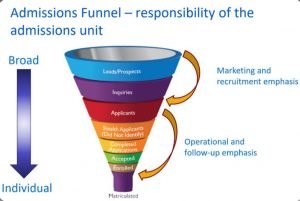ADMISSIONS FUNNEL
Are you interested in knowing more about admissions funnel? If so, then you are on the right page. Feel relaxed and make sure you read the article to the end.

College admissions can be a complicated process. Students can easily become overwhelmed by the nearly 4,000 domestic colleges and universities available to them. For colleges, competing for the right student alongside a sea of options is just as daunting. To increase the number of matriculated students who enroll in your institution, it’s crucial to effectively leverage your admissions funnel.
What is an admissions funnel?
Admission or enrollment funnel is a series of steps that a lead (student) must cross – right from being a lead, to a prospect, to a hot opportunity to finally becoming a student. In short, it is a picturized representation of a student’s journey from inquiry to conversion.
There are three distinct stages of an enrollment funnel – Top, Middle, and Bottom. Based on how much a student is interested in admissions, you can determine their stage in the funnel.
If you are wondering why we call it a funnel, it is because casual inquiries (top of the funnel) will always be more than the admission-ready inquiries (bottom of the funnel). Let us discuss these stages of the admissions funnel.
This funnel is meant to visually illustrate the journey prospective students take as they progress through your school’s admissions process. In higher education, the student journey is made up of three stages, each of which closely aligns with the admissions funnel.
*Awareness Stage: Prospective students become aware of the urgency to start searching for a college or university.
*Consideration Stage: Those students begin evaluating different institutions, comparing and identifying the options that best meet their needs.
*Decision Stage: The students have finished evaluating their options and are ready to make a final decision.
Ideally, a prospective student will enter the admissions funnel at the Awareness Stage and eventually progress to the Decision Stage. However, the reality is that “enrolls” account for a very small percentage of the funnel. To better understand how prospective students move through the admissions process, it’s often broken into three, more general sections.
Top of the Funnel
The top of the funnel represents the Awareness Stage of the student journey, and encompasses both prospects and inquiries. The purpose is to raise a prospective student’s awareness of their needs that your college or university can address. In the end, the goal is to convert prospects into inquiries, and inquiries into applicants. This is accomplished with awareness campaigns like in-person recruitment events (e.g., college fairs and high school visits), content marketing, search campaigns, and more.
Middle of the Funnel
The middle of the funnel is attributed to the Consideration Stage of the student journey. This part of the enrollment process includes both applicants and admits. Remember, students who’ve applied and been accepted to your institution aren’t guaranteed matriculations, as most students apply to multiple colleges. According to Princeton Review’s 2021 College Hopes & Worries Survey, approximately 40% of prospective students plan on applying to between five and eight colleges, and 32% apply to more than nine.
The middle of the funnel can be a difficult part of the process to navigate, as students don’t always enter the funnel as prospects. While your school’s marketing messages likely attract many of your students, other forms of marketing such as word-of-mouth or print marketing are oftentimes more difficult to track. There are a number of application stages to consider:
*Stealth applicants: Those who enter your funnel directly at the application stage and are unknown as an inquiry.
*Started but not submitted applicants: Those who have started their application, but haven’t submitted it for review. Within the Common Application these students can be identified as suspects, those who have added your college to their My Colleges list, and prospects, those who have answered start term and admissions plan questions on your institution’s member screen.
Bottom of the Funnel
The bottom of the funnel represents the Decision Stage, those who have committed to your institution, including deposits and enrolls. These students require continued nurturing. Leading up to the start of an entry term, deposited students may withdraw their deposit. This is referred to as “melt.” Melt occurs for a variety of reasons, including financial aid concerns, being removed from another institution’s waitlist, or opting for a gap year. Therefore, it’s important to keep in mind that even though a student submits a deposit, this doesn’t guarantee that they’ll convert to an enrolled student.
Enrolled students represent the smallest portion of the admissions funnel. These are the students who have progressed through the entire funnel and matriculated as a result. It’s important to remember, however, that enrollment marketing doesn’t conclude with a matriculation. Retention of current students, as well as building relationships with alumni and donors are all crucial elements of a successful strategy. So don’t neglect them in your marketing efforts!
How Has it Changed?
In recent years, with the widespread availability of information on the web, easy-to-use online application systems, and changing demographics, the enrollment funnel has evolved into a less centralized and more complicated paradigm.
For instance, prospects may not respond to initial contacts but still apply (skipping the inquiry stage), while other students choose to remain anonymous until the point of application.
These shifts have led enrollment managers to adapt multi-dimensional approaches to student recruitment. In addition to implementing robust communication plans at each stage in the enrollment process, admissions offices now place greater emphasis on optimizing their websites, and meeting the expectations of “secret shoppers” with tools like virtual tours, social media and mobile resources.
Enrollment Communications
Recruiting our class requires multiple touchpoints during each stage of the process. The Enrollment Communications staff complements in-person recruitment by reaching new audiences and expanding pre-established connections.
READ ALSO:CAR SPEED UP AND HIT ME WHILE MERGING
The following is a brief overview recruitment tactics and operational structures for each traditional stage of the funnel.
Prospect Stage
The prospect stage refers to inquiry-generation strategies which include:
*Student Search: We conduct a nationwide search for high-achieving high school juniors and sophomores.
*Recruitment Travel: Admissions counselors attend college fairs and visit high schools across the country and internationally.
These programs help build brand awareness and expand our pool of inquiries for future classes.
Inquiry Stage
After students express interest in Stony Brook, we begin messaging them with a broad array of e-mail and print communications.
*Personalized Communications: Each inquiry is processed through our Customer Relationship Management (CRM) system, which allows us to send customized communications based on academic interest, source of inquiry, and other demographic data.
*Viewbook: All inquiries are mailed this publication, which contains information about academic programs, ways to get involved in student life and our value.
*VIP Portals: Inquiries are also given access to personalized VIP web portals, providing customized information about their academic and extracurricular interests, as well as a checklist of the steps they need to take to apply for admission.
*Calls to Action: An assortment of communications encourage inquiries to:
>Apply for admission
>Visit our campus
>Take a virtual tour
>Join online chats
>Meet admissions counselors visiting their high schools
Applicant Stage
The Admissions Office processes more than 40,000 applications per year, and performs a holistic review of each applicant’s credentials. To help manage the volume of applications, as well as the expectations of applicants for status updates, we have adapted a series of efficiencies:
*Document Imaging: All applications and credentials are digitized into our imaging system, optimizing the review process.
*Enrollment Research: High-level statistical analyses are run so that we can predict the exact number of students to admit to meet the University’s multi-faceted enrollment goals.
*Self-Service Tool: Applicants use the University’s self-service portal (SOLAR) to check their application status and view a list of missing items.
*Proactive Outreach: A network of e-mail notifications alert students when their applications are complete or when items are needed.
Admit Stage
The Admissions Office coordinates an assortment of programs to assist admitted students and their families with their college section.
*Admitted Student Days: All-day events offering opportunities to interact with faculty and tour campus facilities.
*Out-of-Area Receptions : Admitted students and their families attend receptions in other states and nations.
*Visit-a-Class Program: Select students are given the opportunity to sit-in on a class in a preferred area of study.
*Brookhaven National Laboratory Tour: Top students in the STEM disciplines tour state-of-the-art facilities such as RHIC, NSLS, and the Center for Functional Nanomaterials.
*Financial Support: We reward high-achieving students with merit scholarships and offer need-based aid to those who qualify in the form of loans, employment opportunities, and grants.
Online Engagement: Our private social network, group online chats, and interactive webinars, and other social tools help integrate students into our community.
How can can colleges reinvent the admissions funnel?
Managing your enrollments and inquiries on excel or multiple platforms might serve the purpose for now. It however gets KO’d when we consider a consolidated enrollment management tool. With the help of an enrollment CRM, educational institutions can manage, try, and test best working strategies in the student enrollment process. Gaining visibility into the admissions funnel makes it easier to push inquiries to enrollments faster.
The CRM also helps your admissions team to capture student inquiries, check their eligibility, follow-up, collect documents, and complete the application process digitally. From a student’s standpoint, it allows them the flexibility of applying to your courses online at the comfort of their beanbags, check their application status, submit documents, pay fees online, schedule screening tests, and way more. Thus, it reduces a typical month-long student journey filled with tedious paperwork.
With LeadSquared’s end-to-end enrollment CRM backing your admissions team, ensure quicker student conversions.


